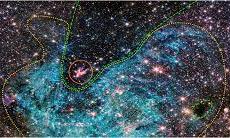
NASA's James Webb telescope unveils unseen image of Milky Way's core
text_fieldsNASA's continuous exploration of galaxies and celestial bodies has unveiled a striking new image, captured by the James Webb Space Telescope. It offers an unprecedented view of the dense core of the Milky Way galaxy.
The recent Instagram post by NASA presented an awe-inspiring glimpse into the heart of our galaxy, showcasing an area known as Sagittarius C with remarkable clarity and intricate detail.
This region, positioned approximately 300 light-years away from the supermassive black hole at the Milky Way's centre, remains an intriguing subject for astronomers due to its enigmatic features yet to be fully understood.
The image captures the mesmerising spectacle of Sagittarius C, revealing an array of celestial elements and an astonishing count of approximately 500,000 stars, each varying in size and age. Particularly noteworthy within this stellar congregation are the protostars - compact regions of dust and gas in the early stages of star formation. Of notable interest is a colossal protostar at the core of the cluster, boasting a mass exceeding 30 times that of the Sun.
The cloud the protostars are emerging from is so dense that the light from stars behind it cannot reach Webb, making it appear less crowded when in fact it is one of the most densely packed areas of the image, said NASA in its blog.
According to NASA, the image vividly illustrates the radiance emitted by these protostars as they release glowing material, creating luminous spheres amidst the dark backdrop.
Samuel Crowe, the principal investigator of the observation team from the University of Virginia, emphasised the groundbreaking nature of this observation, heralding Webb's ability to unveil previously unseen details and facilitate a deeper understanding of star formation within such environments.
Additionally, the image highlights ionised hydrogen emissions surrounding the lower edge of the stellar region, depicted in cyan hues.
Astronomers are grappling with the unprecedented volume of energised gas observed, far surpassing the expected output from young massive stars. Intriguingly, irregular structures resembling needles are also observed within the ionised hydrogen, arranged in a seemingly unordered manner.
Jonathan Tan, an astronomy research professor at the University of Virginia, stressed the significance of the galactic centre as a testing ground for star formation theories. He highlighted the extreme conditions prevailing in this region, allowing scientists to push the boundaries of existing theories.
Ruben Fedriani, a co-investigator at the Instituto Astrofisica de Andalucia in Spain, described the galactic centre as a dynamic space marked by turbulence and the formation of stars, producing impactful winds and radiation that influence the surrounding gas clouds.
It is about 25,000 light years from Earth and scientists can study it with the help of the Webb telescope.























